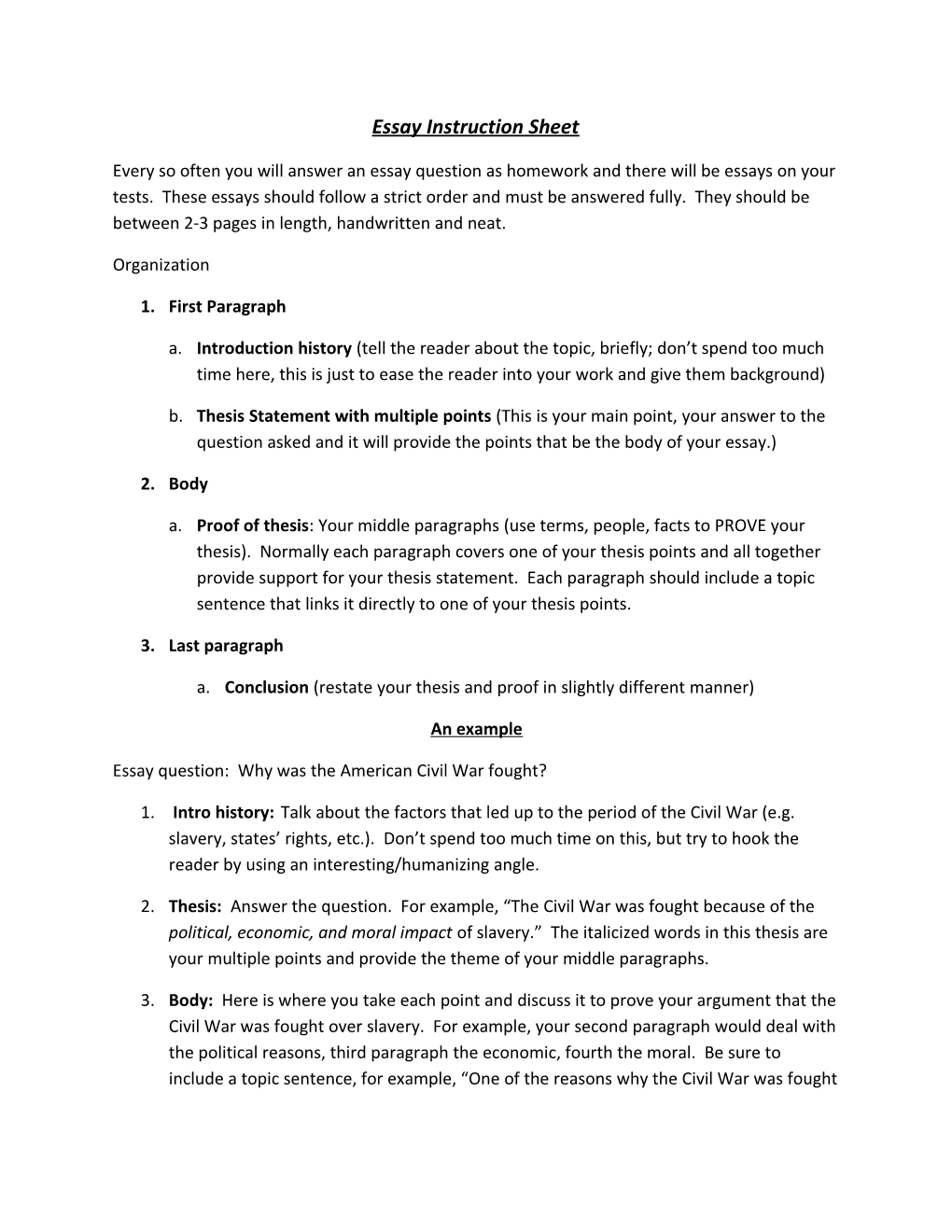Essay Instruction Sheet
Every so often you will answer an essay question as homework and there will be essays on your tests. These essays should follow a strict order and must be answered fully. They should be between 2-3 pages in length, handwritten and neat.
Organization
- First Paragraph
- Introduction history (tell the reader about the topic, briefly; don’t spend too much time here, this is just to ease the reader into your work and give them background)
- Thesis Statement with multiple points (This is your main point, your answer to the question asked and it will provide the points that be the body of your essay.)
- Body
- Proof of thesis: Your middle paragraphs (use terms, people, facts to PROVE your thesis). Normally each paragraph covers one of your thesis points and all together provide support for your thesis statement. Each paragraph should include a topic sentence that links it directly to one of your thesis points.
- Last paragraph
- Conclusion (restate your thesis and proof in slightly different manner)
An example
Essay question: Why was the American Civil War fought?
- Intro history:Talk about the factors that led up to the period of the Civil War (e.g. slavery, states’ rights, etc.). Don’t spend too much time on this, but try to hook the reader by using an interesting/humanizing angle.
- Thesis: Answer the question. For example, “The Civil War was fought because of the political, economic, and moral impact of slavery.” The italicized words in this thesis are your multiple points and provide the theme of your middle paragraphs.
- Body: Here is where you take each point and discuss it to prove your argument that the Civil War was fought over slavery. For example, your second paragraph would deal with the political reasons, third paragraph the economic, fourth the moral. Be sure to include a topic sentence, for example, “One of the reasons why the Civil War was fought was because of the economic impact of slavery.” Then explain the economic impact of slavery using terms, people, events, and other information you studied to show that.
- Conclusion: Here is where you remind the reader of what you just proved. Example: “In conclusion, the American Civil War was mainly a struggle against the political, economic, and moral injustices of the slavery system.” In other words, the conclusion is just rewording what you’ve already said.
If you have any questions or need assistance please let me know and I will be glad to work on this with you.
Grading Rubric for Essays
Blank essays or ones found to have been copied/plagiarized will receive zero (0) points.
Written communication (50 points)
Organization
Inadequate (10 points): There appears to be no organization of the essay’s contents.
Needs Improvement (15 points): Organization of the essay is difficult to follow, due to inadequate transitions and/or rambling format.
Adequate (20 points): The essay can be easily followed. A combination of the following is apparent: Basic transitions are used; a structured format is used.
Professional quality (25 points): The essay can be easily followed. A combination of the following is apparent: Effective transitions are used; a professional format is used.
Mechanics and grammar
Inadequate (10 points): Sentences and paragraphs are difficult to read and understand due to poor grammar or mechanics
Needs improvement (15 points): The essay contains numerous grammatical and mechanical errors.
Adequate (20 points): The essay contains minimal grammatical or mechanical errors.
Professional quality (25 points): The essay is clear and concise and contains no grammatical or mechanical errors.
Content (50 points)
Correctness of facts
Inadequate (10 points): Most facts are wrong.
Needs improvement (15 points): Some facts are wrong.
Adequate (20 points): Technical details are generally correct.
Professional quality (25 points): All facts are correct, and the technical explanation is both concise and complete.
Completeness
Inadequate (10 points): Did not address some of the questions.
Needs improvement (15 points): Addressed the questions, but provided few details.
Adequate (20 points): Address the questions, but left out some details.
Professional quality (25 points): Addressed all questions completely.
